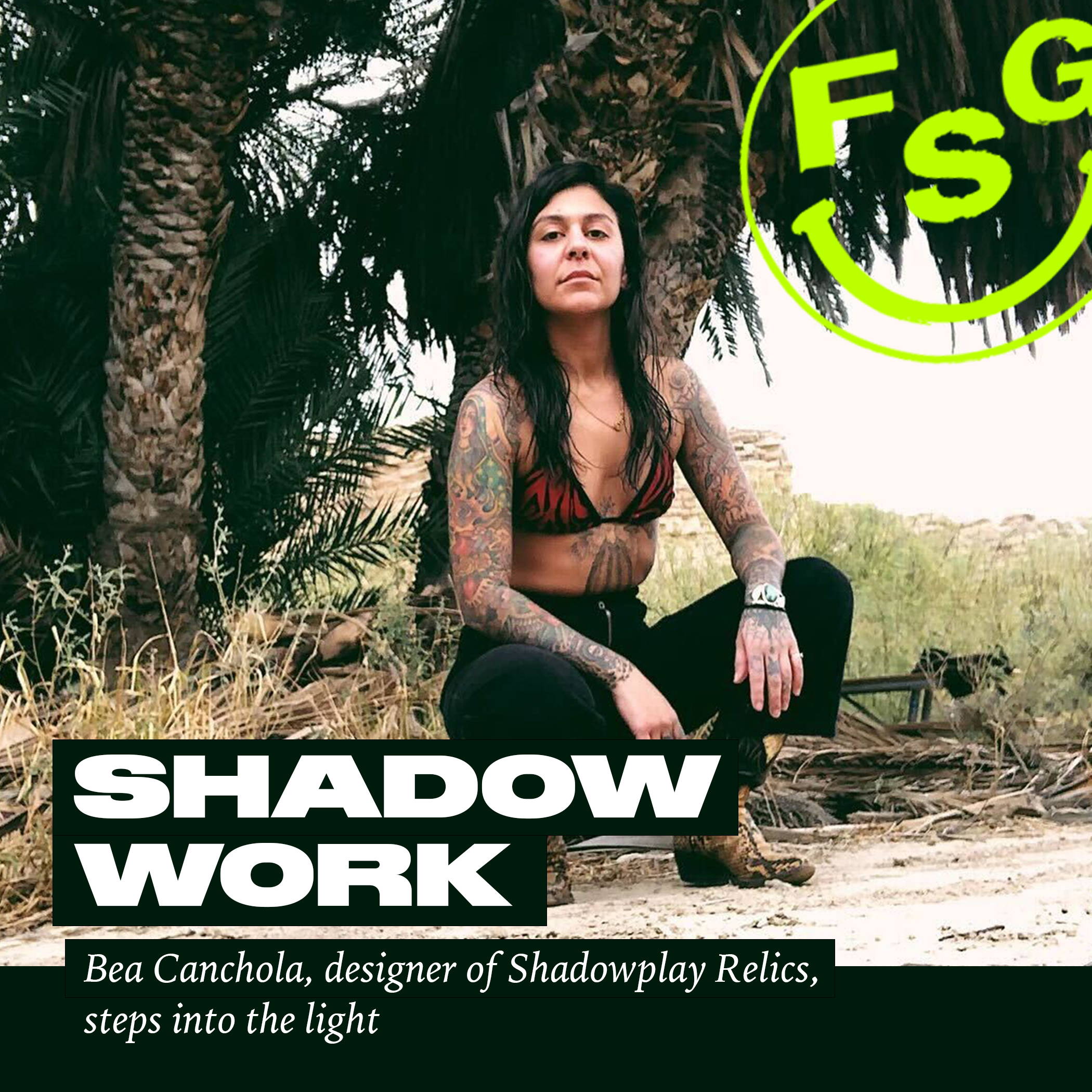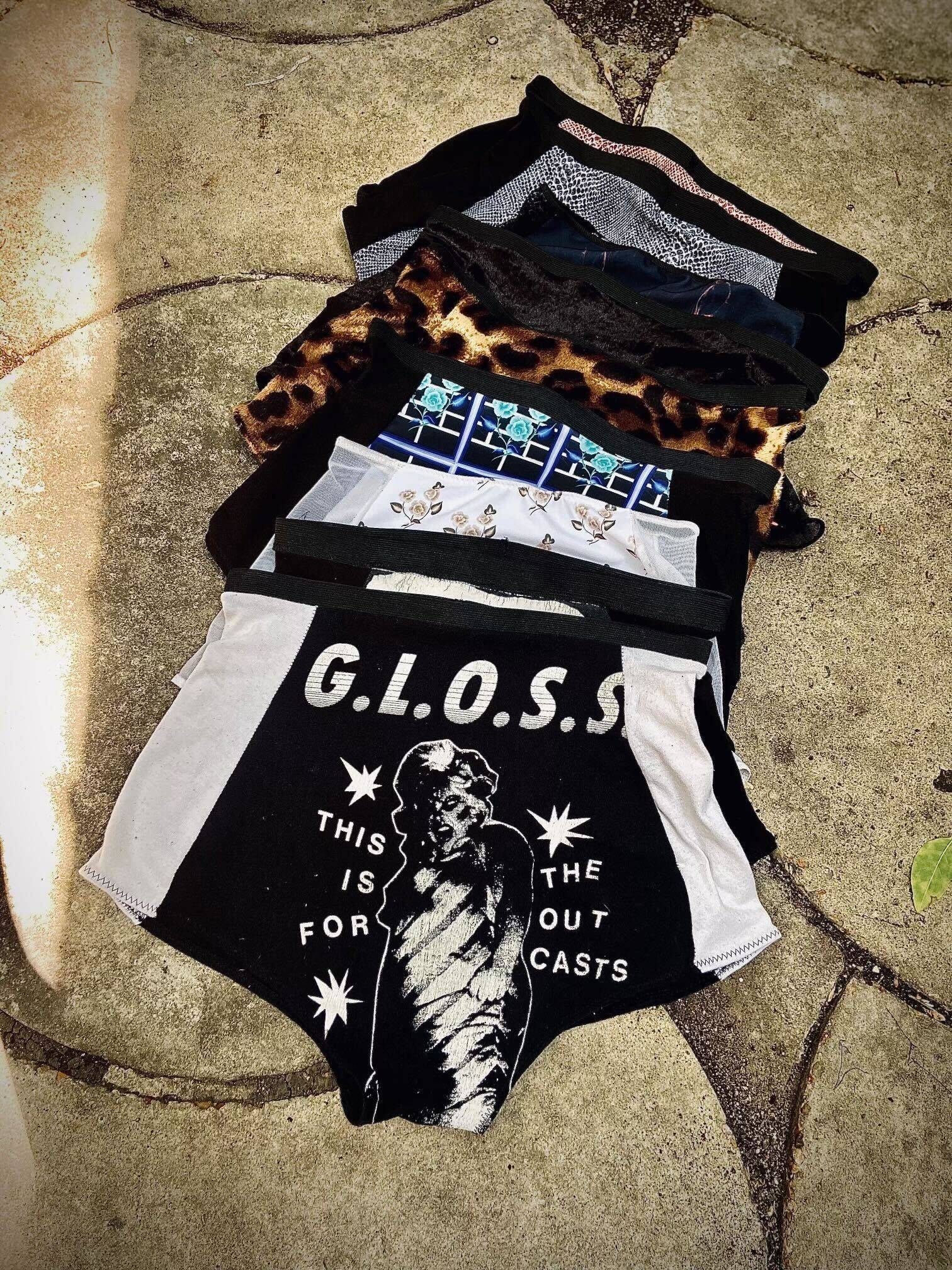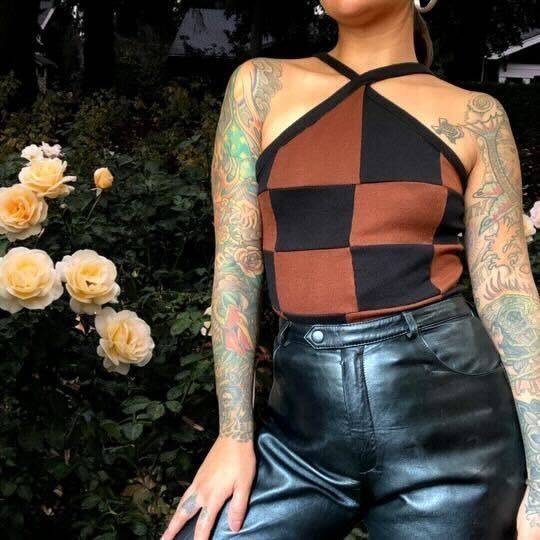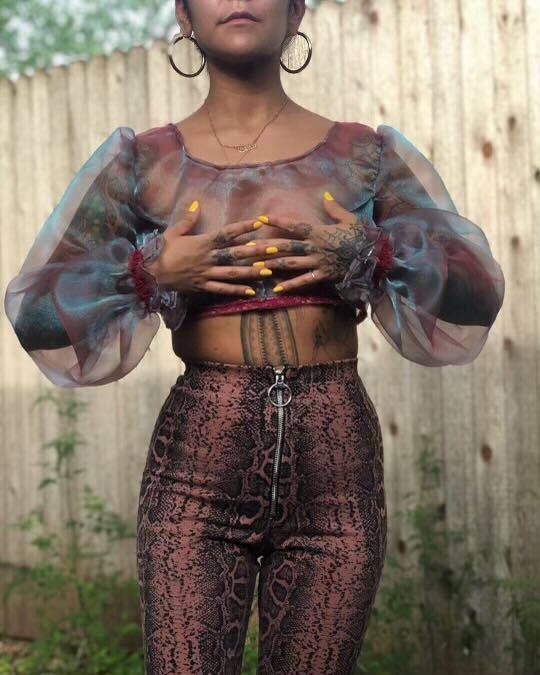FREE SHIPPING ON ALL U.S. ORDERS OVER $100

By E.S. Sparks
Cenizo, also known as Texas Sage, is the official native shrub of the state and characterized by its resilience. Its violet blossoms are eye-catching, while its ability to thrive in lime-rich, rocky conditions and sweltering sun-drenched droughts make it stronger than its somewhat humble stature would suggest. They are beautifully accessible (which is not to say commonplace), and versatile enough to withstand the shade. Earthy, but potent.
To quote the beloved singer Selena, another Texan native and personal inspiration to the designer who has taken root in my mind as this exquisite but grounded bloom:
“Como la flor, con tanto amor.”
Bea Canchola is the designer and owner of Shadowplay Relics. Self-taught and starting in 2019, she has quickly become a force in local fashion. A pura Tejana artist, her focus is in exploring the self through creation, breathing new life into found materials. By repurposing old treasures into universally flattering silhouettes, she uses her keenly resourceful and imaginative eye to create pieces that will stand the test of time.
We met in the sewing department of FSG a year ago and became fast friends, born out of a mutual respect for each other’s creative fixations and a nuanced understanding of the underlying motivations that drive us. Here, we unearth the origins of Shadowplay Relics, catch up on her current state of mind, and peer into what the future holds for this independent spirit.
Tell me about the first garment you ever made.
The first thing that I made was an organza, puffy-sleeved crop top. I hadn’t touched a sewing machine in over ten years. I had moved from Victoria to Austin and brought it with me and never used it! I was really discouraged by my first sewing experience when I got the machine because I couldn’t make a piece of clothing from a pattern. I gave up long ago on that.
Then I had the time and I was like, I’m going to try this again, I’m not going to give up. This was 2019, before the pandemic. And my first piece was this organza top that I paired with these pants [shows me the first photo on the Shadowplay Relics Instagram] and it was a hit. People were like, “That’s amazing!” It was weird how many people reacted to this in a way that was very positive. At the time, I think I really needed that direction, because I didn’t really have anything going [on] at that point. Painting and all that stuff was great, but I just didn’t know where to go with that. So I think the encouragement is kind of what helped boost me and get me to keep doing it. It was a nice challenge and at the end of it, it was rewarding. I like that feeling so I want[ed] to continue to push myself and learn and grow and share with people. And if people want to rock it, hell yeah that’s cool!
What are some inspirations you like to draw from?
I’m very inspired by the goth scene. Goth rock. Country, Tejano. Selena, who I love. I kind of wanted to tie in the dark elements of what I like—dark, sexy shit—mixed with native Texas roots. So I was trying to make things that were very interesting and intricate, but still like, Girls, throw on some boots. Where’s your cowboy hat? Throw it on and go!
Back [in the beginning], a lot of my clothing [item] names would be song names. The Cure, “Play For Today,” you know… I wanted to name it an experience, a feeling, just trying to figure out a unique way to describe these pieces. I feel like people identify with names and titles and music and all those things so I wanted to kind of incorporate that.
Speaking of names, what does [the name of your clothing line] Shadowplay Relics mean to you?
I think on the surface it doesn’t exactly share as much of the vulnerability as it really does mean to me. If you know, “Shadowplay” is a song by Joy Division, I don’t know the lyrics off the top of my head right now—
Let’s listen to it! [Starts to put the song on.]
Okay [laughs]. But if you get into it, it’s very relatable when you’re in a dark place. [As a kid] I wasn’t a very outgoing, bright ball of joy, okay? [Laughs.] I was a very emotional, in my head, self-conscious young person.
Turn it up and just listen to the beginning of it.
[We listen to the first verse.]
“In a room with no window… I found truth.” So I listened to this song on repeat probably for an entire day when I was just trying to figure out a name. Where my head was. Just kind of lost, like, What am I doing? What do I want out of life? What do I identify with? Who are you? What do you want to be?
[I’m] very interested in Carl Jung, personally. Really interested in self-workings and understanding yourself. And Carl Jung, what he would do was “shadow work,” basically identifying things that bring you down, bring you darkness. Accepting that is a part of you, but that doesn’t mean that that’s just you. Then obviously listening to the song and hearing that—I was just in a place of being alone. And it was very isolating. For me, the only way I can find some joy in that experience was to just create.
I think also just really fucking loving Joy Division, [their] whole story is beautiful and sad at the same time. I felt like in a way I was doing the shadow work, but I didn’t want it to just be work. I wanted it to be fun. Not have it be a job but getting to know myself again. Being vulnerable and putting it out into the world.
Not to belabor a point, but I feel like with Joy Division their sound came from the claustrophobic setting of being in Manchester and feeling imprisoned in a way. Do you relate to that with your art, coming from Victoria, Texas?
Oh yeah. Just getting to that point of sitting alone for weeks on end, MONTHS on end actually, and really just sitting with it, that’s what it felt like. But it was weird because in my experience Victoria is a very quiet place, even just during the pandemic I was in a very safe, quiet place. I think the claustrophobic, loud [sensation], that came from myself. And the experience of what was going on and the unknowing of like, What the fuck is happening in this world right now?
And also just the day-to-day! I’m an adult, I have to be self-sufficient, so how am I going to do that? It’s very loud in there, internally. [Laughs.] And I don’t like to dump, I don’t like to project it, I like to sit with it. [Starting Shadowplay Relics] was kind of my own way of learning how to work with it so I wouldn’t be consumed by it.

Your work is very much grounded in reality. Do you think you’re burrowing into that reality or is there some escapist element, even though your stuff isn’t necessarily fanciful or outrageous? How do you “build a world”?
I think it gives me a foundation. Making things that are very classic, or have “been done,” it gives me a foundation of what to start with. Once you have the foundation, then you have a general understanding of how to construct, and then you can start changing things up. Remixing things in ways and eventually getting to a point where things are a little more artsy and interesting.
Like, I love drag queens. They are just the epitome of confidence to me. And I did get to work with one local drag queen for a fashion show, Louisiana Purchase. I created a garment for them that was 100% custom. That was an experience for me because I don’t [typically] work with those materials, but I knew I could make this piece for them and they’re going to do it up with the makeup and accessories. Maybe having the foundation helps me understand where it can go and how to get more creative with it and seeing what I can add as the time goes by. If you’re constantly in practice with something it starts to get a little easier.
So would you say a fundamental for you is shaping something to fit someone on a personal basis?
Yeah, seeing how it fits first. Granted we are in Austin so there are people that are dressing very stylish and out-there. This is the first place I’ve really been where, yeah, people are wearing lingerie out in the streets. You don’t do that in Victoria! People are more willing to take risks here in this city, which is great. I definitely like to make things that are more for everyday, something you throw on real quick and you still feel comfortable and confident in it, but I’m not limited to that.
Let’s be haters for a minute. Is there anything you would banish from the fashion lexicon forever? Something you just hate and would love to see gone?
The fashion in the Y2K. But also, I understand its place and I don’t want to banish it necessarily. Low-rise jeans, I hated them forever.
It’s not flattering!
It’s not flattering on my body! But I’ve met people who it’s very flattering on. And I’m actually in the process of styling garments that I’ve made with this said-Y2K fashion and I’m very interested to see how it turns out because that’s not my realm. I’m working on a fashion show right now…
What can you tell us about what you’re working on for it?
Right now, my mindset is I’m taking all the fabric that I have—my first piece is all made out of repurposed denim. The denim came just from cutting jeans into shorts. Anybody that cuts their jeans into shorts, they [ask me], “Hey Bea, you want this fabric?” So I’ve just hoarded all this stuff. This piece I’ve created is a patchwork corset top. It’s very constructed. You have your shell, an outside piece, and you have your lining, and, I’ll show you… [Takes out her phone and shows me a photo of it.]
It’s giving me sex dungeon! [Laughs.]
That’s all just bottoms of jeans!
I wouldn’t have thought that. I thought it would be denim-colored.
No, black, brown. My earth tones, like I do. I would wear that at [local goth club] Elysium on a Sunday.
YES.
I’d go dance in a cage in that outfit. I’d wear my knee-high boots with a high bun, and I’ll be like fuckin’ Lara Croft. I mean I dress differently all the time, a lot of people do. Not everybody is just in one style and I love it. That’s kind of what this show is supposed to be for me. Yeah, it still has geometric shapes. It has dark colors. It’s kind of this basic construction of one garment, but use the materials you have and see what you can come up with. There is no plan.

That’s where fantasy comes into play because you have to imagine a world in which whatever you’re making would exist on a body and it would thrive outside of yourself. You have to have that imagination.
It all just starts from interesting fabric. Sometimes there’s a piece of material that’s just too good to let go. It’ll turn into what it needs to turn into eventually.
Just give it room to breathe in your subconscious.
Mhmm. And maybe it doesn’t need to be a shirt for its whole life. I just try to figure out how to make that a [garment] for someone. Because I do make a lot of things for myself, and then half the time I’ll make stuff that’s not for me, but maybe someone else will like it. And then it gets a new home and I’m like, That's so great! I hope you keep that forever.

